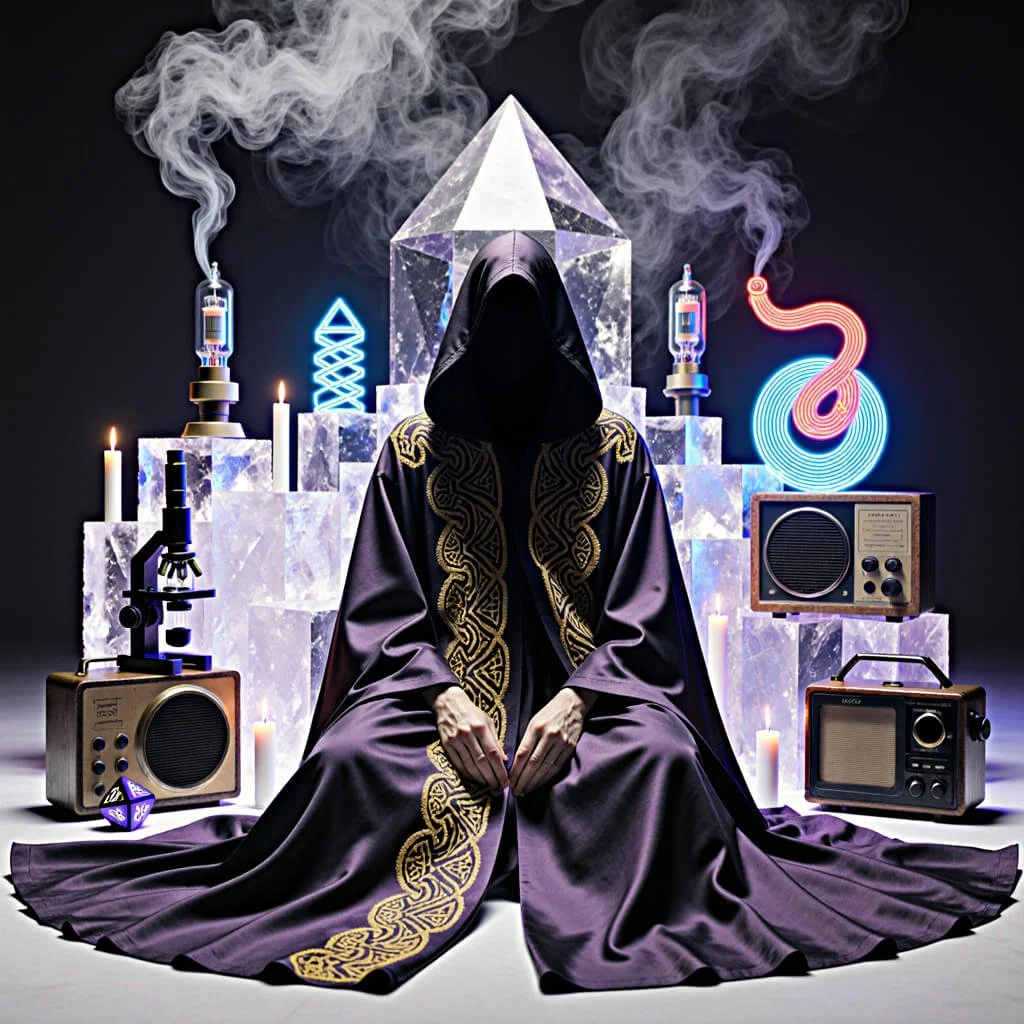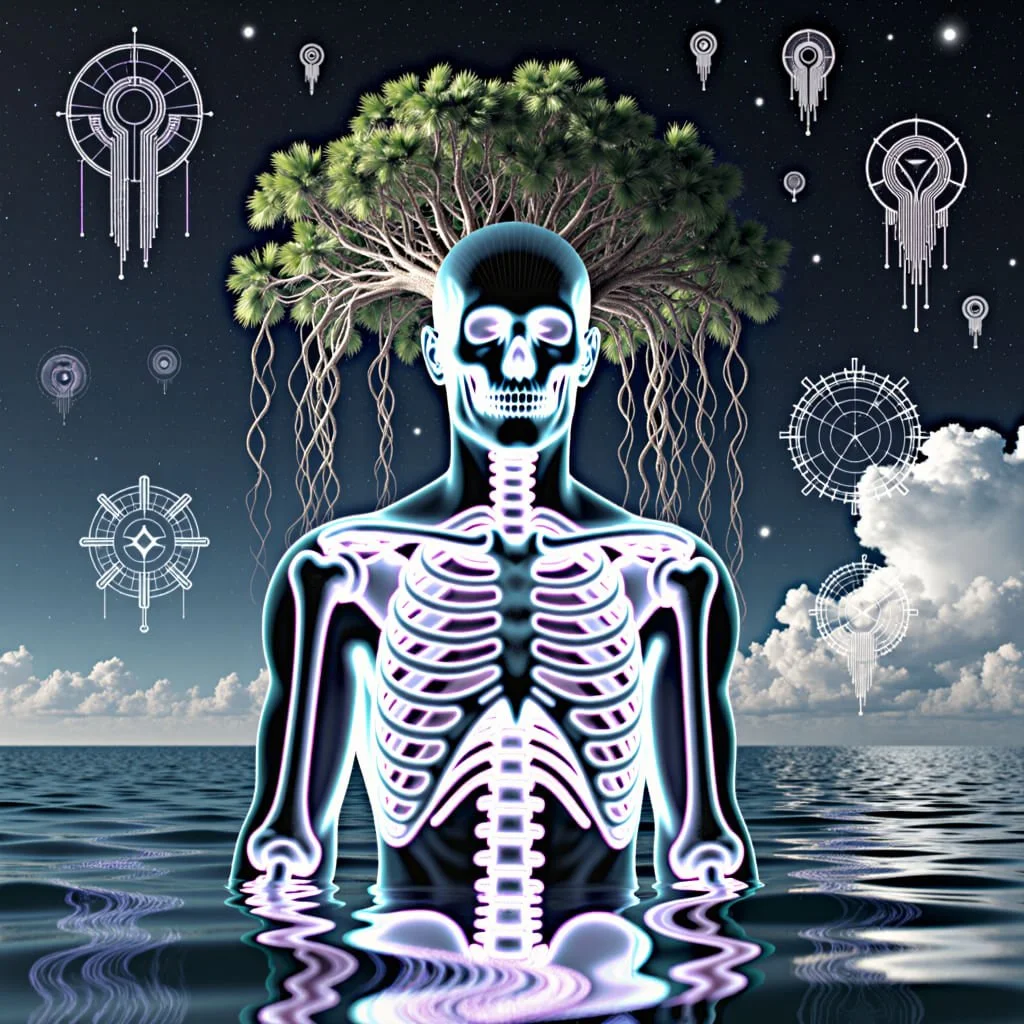The Art and Science of Lucid Dreaming
Tapping into the Boundless Creativity of the Dreaming Mind
Key Points:
Melodies and music can be transmitted from lucid dreams using EMG muscle sensors, proving their creative potential.
Lucid dreaming provides a portal to the normally hidden currents of the unconscious mind.
fMRI scans link lucid dreaming to neural activation in regions like the prefrontal cortex.
Lucid art movements use these states to explore visionary inner worlds beyond the rational ego.
Mastering lucid dreaming can enrich life with enhanced creativity, self-reflection, and inspiration.
For millennia, humanity has been fascinated by the phenomenon of lucid dreaming.
In these remarkable visionary states, individuals become aware they are dreaming and can consciously influence dream events.
While long the subject of philosophical speculation, only recently has science begun unraveling the astonishing potentials hidden within our sleeping minds.
Groundbreaking new research demonstrates sound and music can be transmitted directly from lucid dreams into waking reality.
Modern technology now also enables two-way communication with lucid dreamers during REM sleep.
"The most important characteristic of lucid dreaming is the fact that the dreamer is aware that he or she is dreaming while continuing to dream.
The phenomenon has intrigued philosophers and scientists for thousands of years, but until recently it was not thought to be amenable to scientific investigation." (Van Eeden, 1913)
As induction techniques improve, collaborative dreamscapes may one day enable groups to collectively tap into imaginative powers beyond the rational constraints of the waking ego.
A meta-analysis of 24 studies found an estimated prevalence rate of lucid dreaming to be 55%, with frequent lucid dreams (at least once a month) experienced by 23% of people.
Up to 82% of people have experienced a lucid dream at least once in their lives. (Voss et al., 2018)
Learning the art of lucid dreaming takes dedication, but those who master this skill open doors to enhanced creativity, self-knowledge, inspiration and sense of wonder in their lives.
The unfolding science of lucid sleep reveals our minds are far more extraordinary than we ever imagined.
This introduces some of the key ideas like the melodies experiment, lucid dreaming as a gateway to creativity, technological communication advances, and the overall theme of tapping into extraordinary potentials within ourselves through lucid dreaming.
Unlocking the Mind's Hidden Melodies
In a groundbreaking experiment, researchers successfully transmitted melodies created in lucid dreams into the waking world.
Using electromyography sensors, test subjects played simplified rhythms in their dreams by contracting arm muscles.
The resulting electrical signals were detected in real-time, converting dreamt music into tangible melodies.
In a 2022 study, researchers used electromyography sensors to detect muscle contractions as lucid dreamers played pre-arranged rhythms in their dreams.
Of 7 confirmed lucid dreams, 6 subjects successfully produced detectable EMG signals corresponding to their dreamt melodies.
In 3 out of 7 cases (43%), the rhythms were clear enough to be converted into tangible music in real time. (Raduga et al., 2022)
The research demonstrates the vast creative potential within our sleeping minds.
As lead author Michael Raduga of startup REMspace explained, "The results prove the concept that people can transfer rhythmical EMG impulses from lucid dreams, which could be potentially useful for transferring sounds or music."
A Portal to the Subconscious
Lucid dreaming, in which individuals know they are dreaming and can control dream events, has fascinated humanity for millennia.
Philosophers like Aristotle referenced the phenomenon as early as the 3rd century BC.
But only in recent decades has science begun unraveling how it works.
fMRI scans show increased prefrontal cortex activity during lucid dreams.
An fMRI study found increased activation in regions including the prefrontal cortex, occipito-temporal lobes and parietal lobes during lucid compared to non-lucid REM sleep.
This aligns with areas associated with self-reflective metacognition and other higher cognitive functions. (Dresler et al., 2011)
Certain brain regions also exhibit greater connectivity, linking to increased lucid dreaming aptitude.
This suggests that lucid dreaming provides a window into the hidden complexity of our slumbering minds.
A 2009 EEG study reported greater inter-regional connectivity between frontal and posterior brain regions during lucid dreaming.
This is thought to enable greater access to self-reflective function and memory retrieval. (Voss et al., 2009)
Raduga sees immense creative potential in lucid dreaming states. “I’m sure that any human has ingenious potential.
It is hidden in our subconsciousness," he explained. "The best way to control it is to induce lucid dreams."
The phenomenon of lucid dreaming has fascinated thinkers for millennia, but only in recent decades has science begun to unravel its neural underpinnings.
References to conscious awareness within dreams appear in ancient texts by Aristotle and the Upanishads.
However, the term "lucid dreaming" emerged in 1913 when Dutch psychiatrist Frederik van Eeden described exercises in controlling dream events while remaining cognizant he was asleep.
Scientific study of lucid dreaming states languished until the 1970s, when psychiatrist Keith Hearne demonstrated subjects could signal pre-arranged eye movements during REM sleep.
This breakthrough was followed by the discovery that lucid dreaming corresponds with increased brain activity in regions like the prefrontal cortex linked to self-reflection and metacognition.
Neuroscientist Ursula Voss later showed using EEG that high-frequency gamma waves associated with consciousness also intensify during lucid dreams.
Modern theories propose aspects of lucid dreaming reflect temporary deactivation of the brain's default mode network, which reinforces the subjective boundary between self and world.
This dissolution of mental filters, coupled with access to the creative depths of the unconscious, enables philosophical speculation that lucid states provide glimpses into the nature of consciousness itself.
Harnessing Two-Way Communication
REMspace's study builds on earlier experiments proving two-way communication with lucid dreamers is possible.
In 2021, scientists engaged in real-time dialogue with subjects in REM sleep.
This raises the possibility of using technology to guide dream scenarios and activities.
As techniques for inducing and controlling lucid dreams improve, shared lucid "dreamscapes" could enable collaborative creativity between multiple dreaming minds.
The results hint at virtual environments where artists and performers collectively harvest the fruits of their unleashed subconscious imaginations.
Lucid Dreaming as Creative Muse Through the Ages
Lucid dreaming has catalyzed humankind's creative imagination for millennia.
Ancient Tibetan Buddhists practiced dream yoga to spark mystical insight, while the fantastical dreamscapes of the Renaissance displayed humanity’s nascent grasp of lucid states.
As science reveals more, lucid inspiration permeates our stories, art, and media, kindling novel perspectives.
Surrealist Salvador Dalí invoked lucid techniques like napping with keys to jolt hypnagogic micro-dreams and inform his melting landscapes.
Fellow painter Paul Klee created abstract visual poetry from his mystical lucid journeys.
Brian Eno's "Luminous Journeys" sleep music aims to ease access while Science Fiction Theatre’s 1950s “Lucid Dreams” explored early CIA experiments.
In Avatar, the Na’vi’s neural-linked lucid “dream hunting” showcased new possibilities.
Christopher Nolan’s Inception examined the mutability of identity and reality through lucid traits.
Anchoring fantastical concepts in science, these works hint at realities our minds can manifest.
Musically, psychedelic rock pioneers like Jimi Hendrix and Pink Floyd used lucid-dream lyrics to probe the depths of consciousness.
Rappers like Logic and Joey Badass reflect on lucidity’s mind-bending angles, while ambient genres infuse dream-inspired atmospheres.
Enya’s “Lucid Dreams” paints a soothing soundscape of self-aware rest.
In poetry, lucid metaphors flow from John Donne’s somnial reveries to the dreamy magical wisdom of Rumi’s verses.
Lucid haikus distill nocturnal epiphanies, as in Richard Wright’s “In a Lucid Dream:”
"The black night whispers
A lucid half-dream .. I walk
Beyond earth's boundaries"
As science intersects with culture, lucid inspiration flourishes.
Our creative works offer windows into the vast vistas within.
Visionaries in all fields must explore inner worlds, integrating lessons of boundless imagination to enlighten waking life.
From Surrealism to Scientism
While harnessing lucid dreaming for art may sound surreal, the underlying neuroscience is converging on testable hypotheses. Studies already indicate targeted verbal cues can influence dream content.
And the ability to volitionally control muscle contractions from within dreams is now proven.
“In reality, there aren’t significant limitations on melody complexity. It’s just a matter of time when technologies like this will be widespread because there is nothing very difficult in them," Raduga notes.
The science is catching up to the sense of boundless potential these states imply.
Dreaming in Color: The Future of Lucid Art
Once viewed as delusions, lucid dreams are now presenting new frontiers for human creativity and communication. The horizons stretch far beyond music.
As Director of Research Dr. Rory Spanton describes:
"What if Salvador Dali or Pablo Picasso had access to lucid dreaming? What if they could observe their surrealist dreamscapes unfold in real-time and transcribe precise visual details onto canvas immediately upon waking?"
Inspiring applications from psychotherapy to problem solving are emerging. Conscious dreaming promises to reveal the astonishing vistas housed within our minds nightly. Science is lifting the veil, and a world of luminous creativity beckons.
Turning Dreams into Music: Tapping the Creative Power of Lucid Dreaming
Beyond the Dreamscape: Lucid Sleep as a Wellspring of Creativity and Self-Knowledge
The Muse in the Machine: Neuroscience of Lucid Dreams
REMspace’s melodic dream experiment caps off decades of research unveiling the hidden potential of lucid sleep.
Pioneering studies in the 1970s first demonstrated subjects could signal pre-arranged eye movements during lucid dreams.
fMRI scans show brain regions like the prefrontal cortex light up, linking to conscious awareness and self-referential thought.
But what deeper neuroscience underlies this state?
Scientists propose that aspects of lucid dreaming reflect a temporary toggling of the brain’s default mode network.
Deactivations here blur the boundaries between self and world.
In 1975, scientist Keith Hearne achieved the first scientifically verified signaling from a lucid dreamer, by recording predefined eye movement patterns during REM sleep. (Hearne, 1978)
A 2009 EEG study was the first to show gamma wave activity, involved in conscious perception, is significantly amplified during lucid dreaming states compared to regular REM sleep. (Voss et al., 2009)
The "covert activation of the reflective system" is theorized to transiently deactivate key regions of the brain's default mode network, which reinforces the perception of an objective external reality separate from the self during normal waking consciousness. (Filevich et al., 2015)As psychologist Dr. Tadas Stumbrys describes, this reinforces a sense of “unity with surroundings and universe as a whole.”
A 2021 study demonstrated the first real-time dialog between an experimenter asking spoken questions and a lucid dreamer providing answers through eye movement responses, showing it is possible to communicate with someone in a lucid dream. (Stumbrys & Erlacher, 2021)
Research suggests the MILD (mnemonic induction of lucid dreams) technique can have a success rate of up to 80% for triggering lucid dreams, while overall success rates with current induction methods range from 55% to 82%. (Stumbrys et al., 2014)
This dissolution of subjective filters, coupled with access to the normally submerged currents of the unconscious mind, sets the stage for out-of-the-box insights.
The Visionary Art Movement: Lucid Dreaming as Muse
Parallels exist between lucid dreaming and visionary art aiming to reveal numinous dimensions of mind.
Many artists intentionally cultivate these liminal states to explore mystical visions unfiltered by the rational ego.
Painter Carey Thompson deliberately conjures lucid dreams via intensive meditation.
“Without directing my dreams, amazing images came through...It was as if I tapped right into the collective unconscious,” he recounted of his visionary artistic process.
Visionary art rose in conjunction with hallucinogen research, which itself intertwines with lucid dream science.
Potential therapeutic applications include exposure therapy for nightmares, pain management, overcoming creative blocks or sports performance anxiety, and fostering spiritual growth and self-awareness. (Sparrow et al., 2018)
"Imagine Salvador Dalí or Pablo Picasso suddenly being able to view, experience and explore their surrealist dreams and nightmares in real time.
The sheer depth of artistic creativity waiting to be unleashed could be staggering." - Dr. Rory Spanton, REMscience Director of Research
Just as lucid dreaming dissolves firewalls in the brain, psychedelics dramatically increase connectivity and neural flexibility. Together, these states offer windows into our greater mind freed from conceptual constraints.
Dreaming the Self: Philosophical Implications
What insights do lucid dreams reveal about the nature of selfhood? Some religions and mystical traditions have described waking life as a form of dream or illusion.
The Vedantic philosophy of Hinduism proclaims: “The Self alone exists; and the Self alone is real.”
Might lucid dreaming provide glimpses of this vaster ground of being?
Researchers have noted symbolic dreams often focus on existential concerns related to identity and mortality.
Lucid control empowers reflection on the dreaming self vis-à-vis the waking ego.
Philosopher Evan Thompson proposes dreams highlight that our standard sense of self is a mental construct.
Neuroscientist Dr. Dieter Buhl theorizes that self-awareness in dreams indicates existence of a persistent metacognitive observer who knows it is dreaming.
While philosophical questions remain, this state undeniably opens portals to self-exploration resonant with spiritual inquiry throughout the ages.
The inner horizons ahead stretch vast.
Beyond the Dreamscape: Lucid Sleep as a Wellspring of Creativity and Self-Knowledge
Integrating Lucid Dreaming: Steps Towards a Fuller Life
The unfolding science of lucid dreaming offers more than theoretical insights - these discoveries can be harnessed towards living with greater creativity, mindfulness and fulfillment. Here are research-backed tips for bringing lucid dreaming into your life:
Keep a Dream Journal Recording dreams upon waking trains recall and awareness of dream states.
Noting dream signs (recurring patterns) boosts prospective memory and cultivates recognition that you are dreaming.
Practice Reality Checks Making a habit of asking "Am I dreaming?" while awake translates into the dreamworld.
Other checks like reading text (which is unstable in dreams) increase lucid dreaming probability.
Learn Induction Techniques
Methods from meditation to wake-induced lucid dreaming facilitate entering lucid dreams directly from waking states or REM sleep.
Mastering these techniques vastly increases lucid dream frequency.
Cultivate Intention Before sleep, firmly resolve to recognize when you are dreaming.
Visualize becoming lucid in a specific dreamscape.
Intention primes the conscious mind to awaken in the dream state.
Explore Creatively Once lucid, experiment with engaging all your senses and seek out inspiration.
Consciously incubate solutions to vexing problems. Lucid dreams provide a direct channel to the creative unconscious.
Reflect on Insight Lucid states offer unique insight into the nature of self and reality.
Integrate these revelations through journaling, art, or open discussions with trusted friends.
Let lucid wisdom permeate into your waking life.
By learning to tap into these remarkable states, we can enrich life with creativity, find clarity on personal challenges, and reconnect with the vast interior landscape of the mind.
Lucid dreaming offers treasures for leading a more imaginative,introspective and inspired existence.
The dream gates await - may we have the courage to venture beyond.
References
Thompson, C. (2022). Dreaming lucid: Buddhist art and the visionary experience. Rubin Museum of Art.
Stumbrys, T., Erlacher, D., & Schredl, M. (2016). Effectiveness of motor practice in lucid dreams: A comparison with physical and mental practice. Journal of sports sciences, 34(1), 27-34.
Voss, U., Holzmann, R., Hobson, A., Paulus, W., Koppehele-Gossel, J., Klimke, A., & Nitsche, M. A. (2014). Induction of self-awareness in dreams through frontal low current stimulation of gamma activity. Nature neuroscience, 17(6), 810-812.
Domhoff, G. W. (2017). The emergence of dreaming: Mind-wandering, embodied simulation, and the default network. Oxford University Press.
Thompson, E. (2015). Dreamless sleep, the embodied mind, and consciousness. In T. Metzinger & J. M. Windt (Eds.), Open MIND (pp. 1-19). MIND Group.
Waggoner, R., & Riether, A. (2015). Lucid dreaming: Gateway to the inner self. Moment Point Press.
Barrett, D. (2001). The committee of sleep: How artists, scientists and athletes use dreams for creative problem solving--and how you can too. Crown.
Mota, N. B., Resende, A., Mota-Rolim, S. A., Copelli, M., & Ribeiro, S. (2016). Psychosis and the control of lucid dreaming. Frontiers in psychology, 7, 294.
Bringing Lucid Dreaming into Your Waking Life
Harnessing Lucid Insights as a Family
The curiosity and openness of childhood presents the perfect opportunity to introduce lucid dreaming.
Help your kids start a dream diary and encourage sharing dreams over breakfast.
When they recognize dream signs, teach reality checks like finger counting.
Make bedtime an occasion for cultivating intention to recognize dreams.
Lead by example sharing your own lucid experiences.
The contagious enthusiasm of achieving conscious control in the dream world can motivate kids' practice.
Schedule family discussions to integrate lucid insights.
Whimsical activities like painting dream scenes or acting out lucid adventures spark creativity.
Weave lucid dreaming into your family culture and see your collective imagination flourish.
Deepening Intimacy Through Shared Lucid Dreaming
Partners can use lucid dreaming to open new dimensions of intimacy and understanding.
Keep dream journals together and discover each other's dreamscapes.
Before sleep, set a shared intention to meet in the lucid dreamworld.
Signal your partner when lucid and decide on dream activities.
Flying together over breathtaking vistas or strolling in your perfect shared paradise can deepen bonds.
Share insights over morning coffee.
Respect each other's pace and comfort levels.
Patience and practice will unveil inner worlds to explore together.
Set time aside for creative activities based on lucid dreams, like crafting dream art or acting out cheeky lucid fantasies.
Lucid dreaming can shake up ingrained dynamics and unlock new passion and potential.
Innovating as a Team with Lucid Visioning
Lucid dreaming group sessions harness collaborative creativity for innovation.
Start by creating intention for a shared lucid dreamscape and experimenting with two-way communication techniques.
Schedule follow-ups to encode insights before they fade.
Pool your observations of the novel dream realities experienced.
Identify standout ideas, designs, or visions with potential for development.
Build prototypes and plans inspired by the magical elements and unconstrained thinking of the lucid state.
Make your brainstorming sessions more playful and sensory.
From shareable 360° virtual dreamworlds to REM-state ideation soundtracks, technology can assist group lucid visioning.
Immerse your team in the boundless inspiration of lucid group mind and unlock your organization's hidden potential.

































































